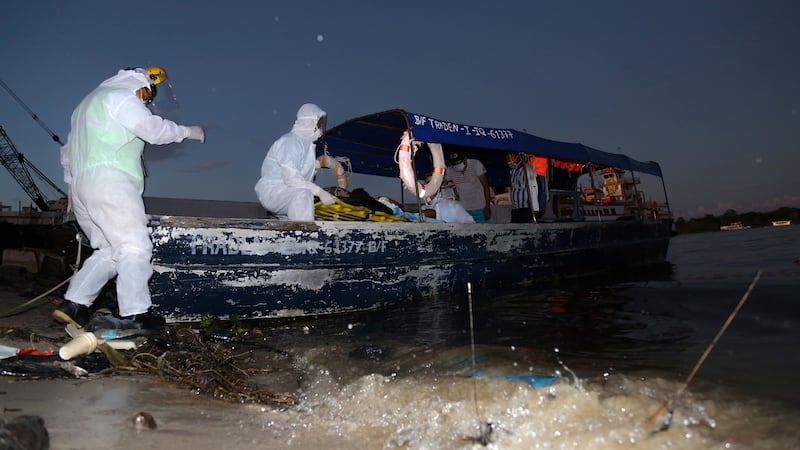The new coronavirus, also known as Covid-19, has infected more than 8.4 million people worldwide and killed more than 453,000, according to figures compiled by Johns Hopkins University.
The actual number is thought to be much higher because many cases are asymptomatic or go untested.
China
China has released genome sequencing data for the coronavirus responsible for a recent outbreak in Beijing, with officials saying on Friday it identified a European strain based on preliminary studies.
China, which had been under pressure to make the data public sooner rather than later as Covid-19 cases mounted in the country's capital, said it had also submitted the data to the World Health Organisation (WHO).
Details published on China’s National Microbiology Data Centre website revealed the genome data was based on three samples – two human and one environmental – collected on June 11th.
That was the same day Beijing reported its first new local Covid-19 infection in months. In the eight days since, the city has reported a total of 183 cases, linked to the sprawling wholesale food centre of Xinfadi in the city’s southwest.
“According to preliminary genomic and epidemiological study results, the virus is from Europe, but it is different from the virus currently spreading in Europe,” Chinese Centre for Disease Control and Prevention (CDC) official Zhang Yong said in an article published on Friday. “It’s older than the virus currently spreading in Europe.”

Several possibilities
Mr Zhang said there were several possibilities as to how the virus arrived in China.
“It could have been hidden in imported frozen food products, or it was lurking in some dark and humid environment such as Xinfadi, with the environment not having been disinfected or sterilised,” Mr Zhang wrote in the article posted on the Central Commission for Discipline Inspection’s website.
Wu Zunyou, the CDC’s chief epidemiology expert, had told state media earlier this week the Beijing strain was similar to Europe’s, although not necessarily directly transmitted from European countries. Wu did not elaborate on those comments made before the release of the genome sequence.
The coronavirus strains found in the United States and Russia were mostly from Europe, he added.
The first major cluster of new coronavirus infections was traced to the Huanan seafood market in Wuhan in December.
Vaccine
Additionally, a vaccine candidate China is developing may not be ready for sale until at least 2021, as researchers struggle to move into large-scale human trials in the country because of a lack of new infections, a senior company executive said.
More than 10 experimental vaccines are being tested in humans globally as scientists race to protect against the virus.
But none of them has yet passed late-stage phase three trials that require thousands of participants to determine a vaccine candidate’s effectiveness.
China, where the virus first originated last year, saw less than 10 new local cases reported daily on average in May, making it less favourable for a late-stage clinical trial.
“We hope we can launch more international cooperations and conduct a multiple-centre phase three clinical study to help bring the vaccine to the market,” China National Biotec Group’s (CNBG) vice president Zhang Yutao told state media China News Service.
“The vaccine won’t be on the market until at least next year based on current plans,” he said in the interview broadcast late on Thursday.
Mr Yang said the number of new patients compared with the population was still too low to make it an ideal trial site.
CNBG is an affiliate of state-backed China National Pharmaceutical Group (Sinopharm). One of the two experimental vaccines developed by its units showed some positive signs in early stage human trials.
State media reported last week that China was offering its two vaccine candidates to employees at state-owned firms travelling overseas.
Spain
The country’s health ministry reported on Friday a total of 28,313 coronavirus deaths, after adjusting its database to remove duplications and errors, and said that there were still nine active clusters across Spain.
The death toll had not been updated since June 7th, when Spain reported 27,136 deaths, while the country was implementing a new methodology for logging deaths and cases.
The new number, which also showed 53 new deaths in the past week through Thursday, is still lower than before the first major revision in late May, when the health ministry lowered the death toll by nearly 2,000.
Spain is preparing to end its state of emergency on Saturday, which will allow free travel across the country and the opening up of its borders to much needed tourism.
As the focus has changed from reining in the pandemic through a strict lockdown to keeping the coronavirus in check via early detection of localised outbreaks, Spanish regions have been reviewing their statistics to resume case-by-case reporting to the health ministry.
Around 34 coronavirus clusters had been detected in the past month-and-a-half, health minister Salvador Illa told a news conference, but the number has come down significantly of late.
Singapore
Meanwhile, Singaporeans can wine and dine at restaurants, work out at the gym and socialise with no more than five people at a time as of Friday, when the city-state removed most of its pandemic lockdown restrictions.
The latest relaxation comes as reopenings in many places around the world are touching off fresh spikes in infections, raising questions about how to live with the virus without causing unnecessary deaths or economic catastrophe.
Getting back to business in Singapore came as China declared a fresh outbreak in Beijing under control after confirming 25 new cases among some 360,000 people tested. That was up by just four from a day earlier.
Singapore’s shopping centre, gyms, parks and other public facilities reopened their doors with strict social distancing and other precautions.
After at first appearing to have been a model for containing the virus, the country of only 5.8 million has one of the highest infection rates in Asia with 41,473 cases, mostly linked to foreign workers’ dormitories.
Authorities say such cases have declined, with no new large clusters and a stable number of other cases despite a partial economic reopening two weeks ago.
Rest of world
The pandemic is waxing and waning in many places, with numbers of cases soaring in Indonesia and India, Brazil and Mexico but appearing to be under control or contained in Thailand, Japan, Vietnam and New Zealand.
Japan’s foreign minister, Toshimitsu Motegi, said on Friday that Japan and Vietnam have agreed to partially lift travel bans and ease restrictions step by step under the understanding that both countries have their outbreaks largely under control.
Vietnam is among four countries that Japan is discussing resuming mutual visits in phases. It is seeking similar arrangements with Thailand, Australia and New Zealand.
Meanwhile, India recorded 13,586 newly confirmed cases on Friday, raising its total to 380,532.
Shops, factories and places of worship have been allowed to reopen while schools and cinemas remain shuttered.
In South Korea, officials reported 49 cases of Covid-19 on Friday as the virus continues to spread in the densely populated capital area of Seoul, where half of its 51 million people live. About 30 to 50 new cases have been confirmed per day since late May.
The number of cases in Saudi Arabia exceeded 150,000 on Friday following a rise in new infections over the past 10 days.
The Saudi ministry of health reported 4,301 new cases on Friday, taking the total to 150,292, with 1,184 deaths. The country hit more than 100,000 cases on June 7th.
Saudi Arabia’s numbers are the highest in the six-nation Gulf Co-operation Council (GCC), which have recorded 366,677 cases and 2,072 deaths.
In the United States, which has the most cases at nearly 2.2 million, states have been pushing ahead with reopenings from full or partial pandemic shutdowns despite surges in cases in many places, including Texas, Oklahoma, Florida and California. – Agencies











